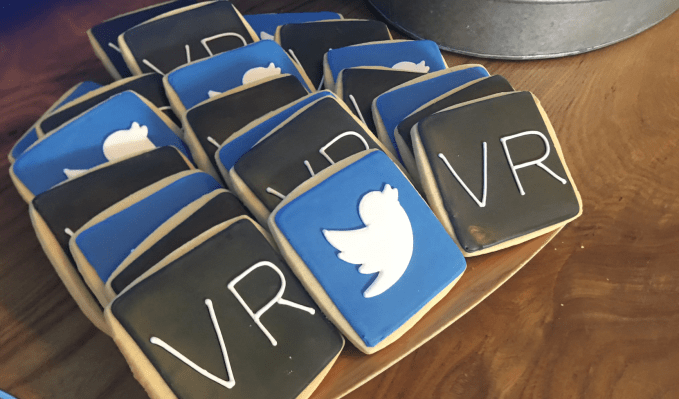PR recovery 101: when you screw up this reality, move on to the next one.
Twitter seems to be slowly building up its AR/VR hires as its other real-world hopes and dreams rise and fall around it. News broke today that the company has hired former AngelHack founder Greg Gopman to start working on virtual reality efforts at the company.
[Update 10/19 11am PT: Greg Gopman now claims he was fired by Twitter less than a day after news broke that the company had hired him as a contractor. Gopman was embroiled in a 2013 scandal over offensive remarks he made about the homeless and the subsequent fallout. Today on Facebook, Gopman wrote “Anddd I’m fired. Thanks TechCrunch”. When friends asked what happened, he added “They wrote a smash piece on me last night and comms didn’t want to deal with it.” When asked for a statement, Twitter provided “no comment”.
Update 10/19 2pm PT: Gopman told TechCrunch “Working at Twitter was actually awesome. Much better than I expected. I worked on an incredible team and we were doing really amazing things. Yesterday we were flying. And now it’s all over. I still love them and wish them the best.”.
Gopman’s claims raise the question of whether Twitter was aware of Gopman’s past remarks about the homeless when it hired him as a contractor. If it wasn’t, it failed to do proper due diligence on a potential hire. If it was aware and hired him anyway, was it appropriate to terminate his contract simply because of news reports about something from three years? -Josh Constine]
Twitter has yet to really announce any major initiatives on the VR/AR front—sure, they may have tested a 360 video or two—but it largely seems like their attention has been focused on other items like the rampant abuse and harassment on the platform.
For a company with such an abuse problem from trolls, it might initially seem like a double win that they’ve hired Gopman, a “VR expert” who’s also voiced his passion for dealing with “degenerates.” That is, until you realize that the “degenerates” he’s referred to as a “burden and liability” were SF’s homeless population.
That’s correct, this is the same Gopman that was lambasted after he lost it in a long-since deleted Facebook rant on SF’s homeless problem. (emphasis is mine)
Just got back to SF. I’ve traveled around the world and I gotta say there is nothing more grotesque than walking down market st in San Francisco.Why the heart of our city has to be overrun by crazy, homeless, drug dealers, dropouts, and trash I have no clue. Each time I pass it my love affair with SF dies a little.
The difference is in other cosmopolitan cities, the lower part of society keep to themselves. They sell small trinkets, beg coyly, stay quiet, and generally stay out of your way. They realize it’s a privilege to be in the civilized part of town and view themselves as guests. And that’s okay.
In downtown SF the degenerates gather like hyenas, spit, urinate, taunt you, sell drugs, get rowdy, they act like they own the center of the city. Like it’s their place of leisure… In actuality it’s the business district for one of the wealthiest cities in the USA. It a disgrace. I don’t even feel safe walking down the sidewalk without planning out my walking path.
You can preach compassion, equality, and be the biggest lover in the world, but there is an area of town for degenerates and an area of town for the working class. There is nothing positive gained from having them so close to us. It’s a burden and a liability having them so close to us. Believe me, if they added the smallest iota of value I’d consider thinking different, but the crazy toothless lady who kicks everyone that gets too close to her cardboard box hasn’t made anyone’s life better in a while.
Twitter did not immediately respond to my inquiry on whether they were aware of Gopman’s past comments.
The revelation of Gopman’s new role comes as news emerges that Twitter’s harassment issues seem to have dissuaded Salesforce and Disney from making bids to buy the company. Given Twitter’s troll problem, you wouldn’t think they would hire someone for their VR program whose past opinions read like some of the worst of the company’s user base (albeit far more wordy than 140 characters can allow).
But then again, Twitter’s moves thus far in VR haven’t made a ton of sense.
While social media competitor Facebook has been at the forefront of VR innovation with its groundbreaking 360 video/audio technologies, Twitter has remained stagnant. Snapchat has gained a great deal of attention for its augmented reality smart filters, but Twitter is still far behind. Inexplicably the company still doesn’t even have a native 360 video viewer available for those wanting to show off that increasingly popular type of content.
With so many AR/VR moves that should be happening, it’s odd that hiring Gopman was the one that Twitter made.
Most of us have said things online that we later regret, and you don’t necessarily want to rake someone over the coals for the rest of their career over one dumb post. But even Gopman’s efforts to make amends for his comments have gone poorly.
Gopman has had a real uphill battle recovering from what he called “the stupidest mistake of my life.” A six-thousand-word Backchannel piece/photoshoot from earlier this year detailed all of the work he’s done in “educating himself” on the plights of the homeless in San Francisco since his FB post. Now, people can and do change, but for all of Gopman’s seemingly tireless work spent bringing notice to the plight of the city’s most needy, there’s always been one person more in need of redemption and attention, himself.
He’s let us take part in his learning experiences alongside him by sharing his experiences to a personal blog and tagging journalists in tweets so they can see how he’s learned to care. All living up to a Silicon Valley aphorism that no good deed goes unposted on Medium.
https://twitter.com/StartupGreg/status/571095951856656384
“Last year I wrote a rant on Facebook voicing my displeasure with San Francisco’s homeless community. It went viral. People thought I was a monster…” Gopman wrote. “But the worst part about it was that it distracted San Francisco from the necessary conversation our community needed to have on reforming our broken homeless policies.”
After a few more self-referential blog posts and lots of data points, Gopman formed a collective to tackle the problem in the best way he knew how, striving to create a homeless community akin to Burning Man. Gopman did not get the positive attention he was expecting. After part of his plan, which involved building geodesic dome shelters for the model homeless, was picked up and torn apart by the media.
Gopman later posted (and deleted) an email (this time on Twitter!) from the Director of Public Policy at the SF Mayor’s Office of Housing Opportunity, Partnership & Engagement. In the email, the official called Gopman a “phony” who was using his efforts to “help clear his google search profile of all the horrible things he said.” Another official told The Guardian that Gopman’s efforts had ceased because “people working with him got sick of his ego.”

Rendered mock-ups of Gopman’s idea for geodesic domes that house the homeless
Distraught with how difficult it was to bring about change to San Francisco’s decades-long homeless problem in one year’s time, Gopman departed on what he called an “Eat, Pray, Love trip in Asia.” Returning from this nine-month sabbatical, he started a job search and settled into a business development position at UploadVR, a virtual reality entertainment/media/working space startup, where he was in charge of recruiting new employees and helping to create something called a “bi-monthly VR Lifestyle nightclub experience.”
He stayed with Upload for about nine months before joining the team at Twitter this month as a VR Program Manager where he’s now working on “partnerships, product launches and recruiting,” areas which Twitter clearly needs to be bringing more positive attention to, something his hiring will likely not do.
For how loud Gopman’s detractors have been on social media, the company where he has just been hired is going about its VR efforts rather quietly.
Twitter’s AR/VR efforts are currently contained within the Twitter Cortex engineering group. It’s headed up by Alessandro Sabatelli, whose VR/AR company IXOMOXI, was acquired by Twitter in June. His startup built an app for the Gear VR called “Lucy,” aimed at music festival goers, which put kaleidoscopic LSD-inspired filters over footage from the passthrough camera on the phone.
Since Sabatelli’s hire, the company has also been looking at how to integrate Periscope with 360 video to establish live feeds of different events that Twitter’s users can experience alongside each other. “Our main push right now is live and how we experience live events together,” Sabatelli told a crowd at an event that Twitter Cortex hosted with UploadVR at the Siggraph 2016 conference.
A job posting on the site urges potential Cortex applicants to “imagine going to the biggest concert ever thrown with millions of people in attendance from all over the world interacting live in new and exciting ways.” A recent update to Periscope brought the ability to stream live video from external cameras, 360 video streaming and live-stitching appear to be on the way for the Producer feature as well so this feature may be coming sooner than others.
Snapchat-style filters are an area that Cortex is also clearly looking to move towards, the company currently has job openings looking for computer vision experts with knowledge of “face detection, recognition, body tracking and/or pose detection.” This is a necessary move, what isn’t clear is why it’s taking so long to bring anything live. Sabatelli has only been in his role since June so he’s not necessarily to fault, but why Twitter has dragged its feet in heightening the computer vision capabilities of its platform is a mystery to me.
It’s possible that the persistent rumors of takeover bids have sidelined major feature movement on the platform, but then again Twitter has always been slow and cautious in expanding its feature set.
VR/AR tech is still very early in its life cycle, but Twitter isn’t even bothering to openly experiment with finding the related features that users will enjoy now on their smartphones. Snapchat has its fun and crazy smart filters while Facebook has one of the largest libraries of VR videos and photos out there (and oh yeah Oculus, an entire VR headset company). Twitter has not only failed to find its own niche but it has failed to even try to replicate the successes of other social media companies.
For large companies, it doesn’t take a whole lot these days to be seen as progressive force in the AR/VR field, but Twitter’s odd inactivity in the space—and today’s questionable hiring decision—don’t seem to be particularly intelligent moves, especially as the company looks ahead to such an uncertain reality.
Additional reporting by Josh Constine
